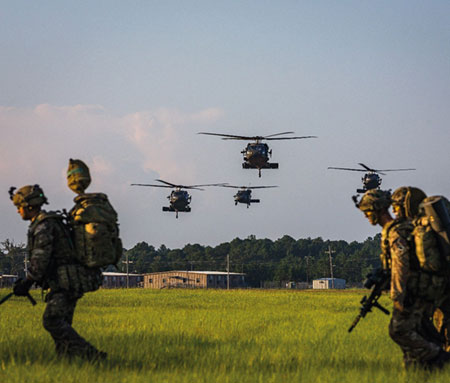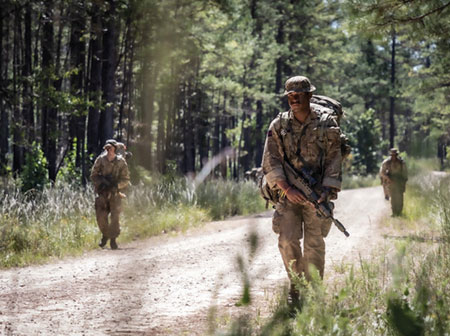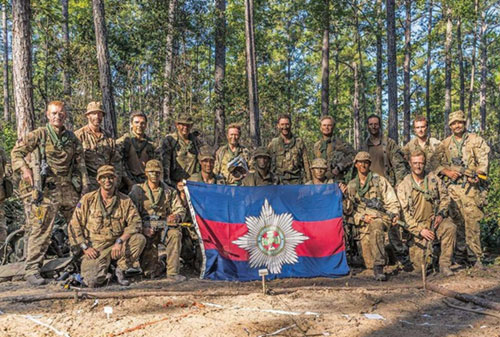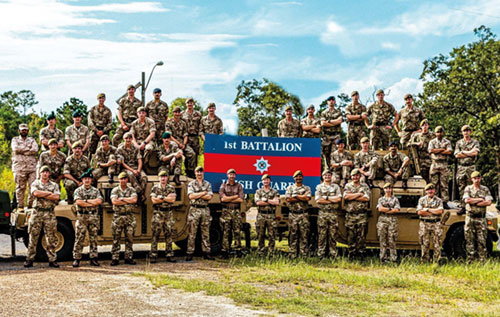|
Exercise RATTLESNAKE
The Irish Guards in Louisiana
by Captain R Howells
Irish Guards
|
The Irish Guards Battlegroup deployed to Fort Polk’s Joint Readiness Training Center (JRTC) in Louisiana in September 2021 to take part in Exercise RATTLESNAKE. Unlike previous iterations of the exercise, which had involved only a company strength attachment from the British Army, the Irish Guards were to be the first battlegroup to take part as a complete battalion. The Battlegroup was comprised of the 1st Battalion Irish Guards, D Company the Royal Irish Regiment, the Queen’s Gurkha Engineers, and 4th Regiment Royal Artillery. Excitement for the exercise had been building for months and when the flights changed due to other RAF operational commitments, there was a concern that we would never quite make it to Louisiana. Fortunately with the help of EuroAtlantic Airways, a Portuguese charter airline company that no one had ever heard of, our fears ceased and we arrived in Louisiana in good order with 10 days to prepare ourselves for the exercise. For those who have not been to Louisiana, the environment is arduous and unforgiving, particularly the heat. Such a humid environment was going to be a great challenge, and in order to adjust to our new environment, the deployment had to begin with a carefully managed acclimatisation physical training programme excellently delivered by Staff Sergeant Qasim. It was a surprise for many how much of an impact the heat can have on the body but the Micks cracked on.
Fort Polk was everything that we expected, particularly for anyone who has watched the film Tigerland. An enormous camp, ‘The Home of Heroes’ encompasses nearly 200,000 acres (bigger than Merseyside) and houses around 10,000 soldiers at any one time. A camp with its own Pizza Hut was always likely to be a hit; that said, many were becoming accustomed to the American military diet with Captain Cosby developing a penchant for a grits-based breakfast. Fort Polk has an extensive history and has been a central hub of operational training for the US Army since the Second World War. Our advance party, headed up by the Quartermaster, Major Allen, arrived in Fort Polk a number of weeks before the remainder of the Battlegroup and worked tirelessly to ensure that all necessary preparation had been done to facilitate a smooth arrival for the Battlegroup in September.

Irish Guards about to insert into the box |
 Irish Guardsmen patrolling the roads of Louisiana Irish Guardsmen patrolling the roads of Louisiana |
Central to success on the exercise was our working relationship with our hosts, the 3rd Brigade Combat Team from the 101st Airborne Division, or the Rakkasans as they prefer to be called. Their nickname derives from the Japanese word for parachute (literally umbrella for falling) given to the Brigade after being stationed in Okinawa in 1945. The greatest challenge of interoperability, as we found, was communication. The use of different equipment and different terms and processes meant that the Battlegroup had to remain flexible throughout. It also took quite some time to explain to our American counterparts that we were in fact members of the Household Division rather than border guards in Ireland.
The Battlegroup adapted quickly to the limited communications platforms we had available and we must thank Major Sylvain and his team from the American Security Force Assistance Battalion who embedded themselves with the Irish Guards Battlegroup and helped act as a link between the Battlegroup and the wider Brigade. Ironing out initial communications issues and working hard to liaise directly with our counterparts meant that the Fighting Micks and the Rakkasans were well prepared to fight alongside each other.
The exercise itself is a brigade level one, established to test an operational brigade in a challenging environment against a realistic and free-thinking enemy force. The enemy force comes from Task Force Geronimo, a US unit whose sole job is to act as enemy forces on this particular exercise. This meant that we were taking on an enemy that had significant experience of the terrain and the nature of the exercise itself. Other threats that the Battlegroup faced in ‘the Box’ included various snakes, insects, and wild pigs.
The exercise is separated into two phases: a twelve-day blank firing exercise followed by a live fire package. The blank phase began with a brigade level air assault with the Irish Guards as the first troops into ‘The Box’. Watching the majority of the Battalion being moved at night by helicopter into the training area was quite a spectacle, demonstrating at first-hand one of the great benefits of interoperability and shared capabilities. The Micks were tasked with establishing a foothold on the ground and securing three key objectives which would allow the ground element of the Brigade the freedom to move into the area, an incredibly important role that unsurprisingly we took in our stride. From there the Battlegroup was tasked with establishing defensive positions as part of the brigade defensive plan. The troops worked hard in difficult conditions to dig their positions where they then had to live for a number of days constantly under threat of a probing attack from the enemy force.
So well-structured were the defences that the enemy had to resort to less conventional tactics, at one stage using a blue light purchased from the internet and disguising themselves as a military police patrol to pull over unsuspecting friendly forces. Fortunately, it was not an Irish Guardsman who fell afoul of this trick!

Final orders group for the attack |
Fighting against a free thinking and effective enemy force made room for heroics on the part of the Battlegroup. Sergeant McNaughton, 2 Platoon’s Platoon Sergeant, was given a ‘Hero Award’ by the American exercise observers for his valiant stand against the enemy force as the majority of his company lay defeated around him. And who could forget the legend of Tom Custer, American Captain and idol of our very own Captain O’Riordan, appearing in the middle of the night armed with only a radio, an anti-tank weapon and in his own words a ‘platoon of bullet catchers’ ready to take the fight to the enemy, forming an eternal bond between No 1 Company and Captain Custer’s Merry Men.
As the defensive phase came to a close, plans were put together for a final attack on the infamous Geronimo DZ (Drop Zone). The attack was set to be an air assault onto the enemy occupied airfield. Estimates were conducted and plans were made as the Micks were to be used as an assaulting force onto the key objective at the airfield. Another brigade level airlift was in the works until the weather turned against us. Heavy rain, thunder and lightning meant that the aircraft had to be grounded and the Battlegroup, at this point already at the helicopter pick up points, was facing the elements head on. A particularly long and wet night for everyone was followed by a welcomed administrative pause, marking the end of the blank phase of the exercise.
Special mention must go to the battle-hardened warriors of the A1 echelon who, under the command of Captain McKernan, faced a great deal more enemy activity than they may have anticipated at the start of the exercise. With regular enemy probes on their location and tasks dictated down from Brigade such as the rescue of two lone US Special Forces operatives from the enemy’s grasp, A1 declared themselves to be the secret weapon of the Battlegroup. Task Force Geronimo certainly got more than they bargained for when entering the A1 battlespace!
As the blank phase came to an end, the Battlegroup reconsolidated and administrated itself ready to begin the live phase of the exercise, which included a four-day range package culminating in a battlegroup level live attack at the end of the week. The training was enjoyed by all involved, particularly the Mortar Platoon who spent the week alongside their US counterparts. Sergeant Barraclough of the 506th Infantry Regiment now proudly hangs an Irish Guards Mortar Platoon flag in his office in Fort Campbell, Kentucky.
At the end of the exercise the Battlegroup gathered to recognise the performance of individuals who had excelled. Notably, Colour Sergeant McCurry and Colour Sergeant Sampat were promoted to WO2 ready for them to take over their new roles as Company Sergeant Majors of No 1 Company and No 2 Company. A memorable place to mark such an outstanding achievement for them both.
After an arduous field exercise, the Battlegroup were given the opportunity to conduct team cohesion for four days in groups of 12. Most of us headed to Austin for a taste of Texan culture, whilst other groups visited Houston and Dallas. Everyone enjoyed a much-needed break, taking the opportunity to refuel with a diet of barbecue food and a few beers here and there! Most importantly, the trip offered platoons the opportunity to bond together.

Officers’ Mess at Endex |
As we look to the future, it is clear for all to see that the relationships forged with our allies will prove to be critical as we continue to fight alongside them. Exercise RATTLESNAKE was a fantastic opportunity for the Battlegroup to put its soldiering skills to the test and enjoy a demanding ‘green’ exercise, but it was also an opportunity for us to create lasting friendships with our allies from across the pond. It was a pleasure working alongside the Rakkasan Brigade and whilst interoperability presents its challenges, these are far outweighed by the positives. Many members of the Battlegroup have made lasting friendships and will have learnt a great deal from operating alongside and under the command of an allied nation. We were also fortunate to work alongside the Royal Irish Regiment and support arms from both the Queen’s Gurkha Engineers and the 4th Regiment Royal Artillery. It is great to see members of the 506th Infantry Regiment who we worked alongside in Louisiana coming to the UK for Exercise LONG MICK on Dartmoor.
Such a strong performance on the exercise has set the standard for other battalions deploying to the JRTC. It was noted that on the Anti-Tank Commander’s Course, run in Warminster, the harbour areas and defensive positions constructed by the Micks during Exercise RATTLESNAKE were used by the US Army as a case study for best practice on how to avoid the impact of enemy indirect fire.
Exercise RATTLESNAKE was a fantastic experience for all those involved. At every level, members of the Battlegroup were given the opportunity to test their soldiering skills in a challenging environment. As our final exercise as a Light Role Infantry Battalion, for the time being at least, we could hardly have asked for a better opportunity than a rotation through JRTC. A battlegroup exercise seemed a fitting way to sign off the year before our commitment to State Ceremonial and Public Duties and the exciting prospects that the future holds.
|
|


 Irish Guardsmen patrolling the roads of Louisiana
Irish Guardsmen patrolling the roads of Louisiana
